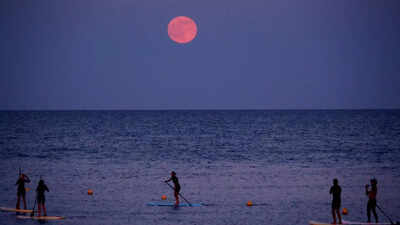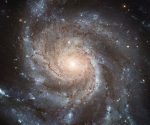Strawberry Moon 2025: June’s full moon to light up the sky this month- know date, time, and the science behind the name | – The Times of India

As summer unfolds, the night skies of the Northern Hemisphere are poised to showcase one of the year’s most captivating celestial events—the full Strawberry Moon. Far more than a poetic name, it reflects a rare blend of seasonal timing, orbital mechanics, and cultural tradition. Appearing in mid-June, this full moon is not only the last of spring but also the lowest-hanging of the year. Its golden glow and low trajectory create a visually striking phenomenon, while its historical significance connects us to ancient rhythms of nature and harvest. For skywatchers, the Strawberry Moon offers both beauty and meaning.
June’s full moon is also known as the ‘Strawberry Moon’
The “Strawberry Moon” is named after Native American Indian tribes, specifically the Algonquin, who based seasonal events around the lunar cycle. Wild strawberries start to ripen in June over much of the Northern Hemisphere, and the sighting of this full moon indicated harvesting time.Other cultures have also provided this moon with descriptive names drawn from their own observations of nature and agricultural cycles. The June moon has been called the Berries Ripen Moon, Green Corn Moon, Hot Moon, and Blooming Moon by Native Americans each for a different aspect of the season’s abundance. In English folklore, it was called the Flower Moon, Planting Moon, or Mead Moon, whereas Celtic cultures provided poetic names like the Horse Moon, Dyan Moon, and Rose Moon. They are not random. They signify the ancient history of human interaction with the Earth’s natural cycles, which is how individuals throughout time and history have utilized the sky to monitor the cycle of seasons and life.
Strawberry Moon 2025: Date and time
Although the moon will technically be at full phase at 3:45 am EDT on Wednesday, June 11, the best time to view it is actually going to be last night—Tuesday, June 10. As the sun sets, the full moon will rise softly over the eastern horizon, providing a lovely and peaceful sight for those who gaze up.To the show, add the light of Antares, a white-hot red supergiant star in the constellation Scorpius. Some 550 light-years from Earth, Antares glows above and to the right of the rising moon. The contrast between the soft golden color of the moon and the red hot color of Antares presents a striking cosmic picture.
Science behind the ‘Strawberry Moon’s low rise’
The full moon this month is the lowest full moon of 2025. As the concluding full moon for spring, the Strawberry Moon tends to look especially low in the northern horizon when observed from north of the equator. This is not an optical illusion but the very consequence of astronomical mechanics.A full moon always happens when the moon is exactly opposite the sun. As the summer solstice approaches, which falls this year on June 20 evening in most parts of the world, the sun is at its highest position in the sky. Since the moon and sun lie on opposite sides of Earth at full moon, the full moon then occupies the lowest arc across the sky. Therefore, the June full moon rises in the southeastern part of the sky at sunset, rides low along the southern horizon through the night, and ultimately sets in the southwest at sunrise.This low altitude produces a stunning visual effect. As the moon rides close to the horizon, atmospheric conditions can make it appear larger and imbue it with a warm orange or golden color. This effect, referred to as the moon illusion, lends the Strawberry Moon an almost theatrical quality.
How Earth’s journey around the sun affects the full moon
Besides its low arc, the full moon this month is also one of the sunniest throughout the whole year. The distance is attributed to the elliptical path that Earth travels around the sun. Earth does not orbit in a complete circle but in a faint oval form, so there are periods where Earth is nearer to the sun (perihelion) and others where it is further away (aphelion).Aphelion falls on July 3 this year, and since a full moon lies directly opposite the sun, June’s full moon is also at its farthest position from our star. The moon will be about 94,600 miles (152,200 kilometers) away from the sun at this time. Although it will not make much of a visual impact to the naked eye, it is a significant factor that highlights the special geometry of this full moon.
What does Strawberry Moon symbolises
The Strawberry Moon is not merely a full moon but an alignment of astronomy, atmosphere, and tradition. With its low trajectory, significant distance from the sun, and deep cultural meaning, this moon offers a unique viewing experience for anyone willing to look up and take it in. Whether you’re in a bustling city or a quiet countryside, the moon’s slow rise at dusk on June 10 promises to be a moment of beauty and reflection, reminding us of the wonder embedded in the natural world.So when darkness approaches and the southeastern horizon starts to shine, take a moment to stop. Allow the low-hanging Strawberry Moon to bond you with hundreds of years’ worth of sky gazers who once stood awestruck beneath the same moonlight.
Strawberry Moon 2025: Related FAQs
What is the Strawberry Moon?The Strawberry Moon is the traditional name for June’s full moon, derived from Native American tribes like the Algonquin. It marked the time for gathering ripening wild strawberries and reflects the deep relationship between lunar cycles and seasonal harvests.When can I see the Strawberry Moon in 2025?The moon will reach full phase at 3:45 a.m. EDT on Wednesday, June 11. However, the best time to view it will be the evening of Tuesday, June 10, just after sunset, when it rises in the southeastern sky.Why is it called the lowest full moon of the year?Because it appears opposite the sun near the summer solstice—when the sun is at its highest—the June full moon travels a very low path across the sky, making it the lowest full moon of the year in the Northern Hemisphere.Does the Strawberry Moon actually look red or pink?Not always. The name refers to seasonal timing, not color. However, due to its low position near the horizon, the moon can appear golden or slightly orange because of atmospheric scattering—an effect known as the “moon illusion.”Can I see any other celestial features during the Strawberry Moon?Yes! As the moon rises, look to its upper right to spot Antares, a red supergiant star in the constellation Scorpius. Its red hue and proximity to the moon create a striking celestial pairing.Also Read | NASA warns! 120-foot asteroid 2025 KX8 to make close approach to Earth on June 4; here’s what to expect
















